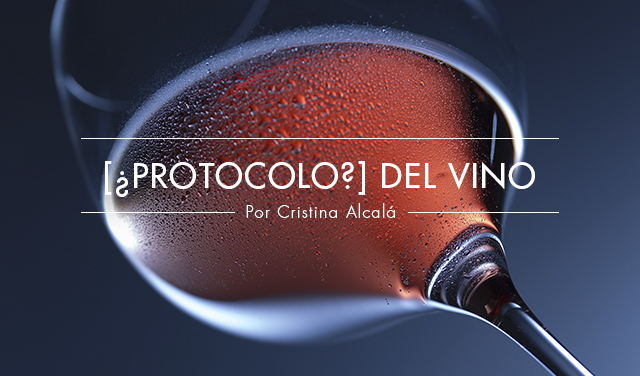[The protocol?] of serving wine

“The rigid nature of the protocol couldn't be further from the true essence of wine.”
I admit that I've never been particularly fond of wine-service protocol. It is true that wine-service professionals—I'm mainly referring to sommeliers and restaurant staff—must know and respect certain basic rules. Some are based on common sense, others acquired through specialized training. In such situations, the protocol is necessary, and it is obvious when it is applied with greater or lesser skill.
My intention in writing this article, however, is not to describe the wine-service protocol in a restaurant setting, but when eating at home, when sharing wine with family or friends. I want to write about what it represents, certain prejudices, what is and isn't done. I want to write about what surrounds the drinking of wine.
Now that we've established the setting, I find the word “protocol” excessive and somewhat uninviting. Strictly speaking, the noun “protocol” refers to order, guidelines, official ceremonial rules, diplomacy by decree or custom, political events. Far too rigid for a bottle enjoyed while dining at home and not the least bit conducive to sharing a relaxed evening with others. Seen in a different light, the word “protocol” could simply be redefined as a few rules informed by attentiveness, refinement or courtesy toward the people sharing our table. An expression of well-deserved respect for what a bottle of wine represents.
The good host and the “pleasures of the table”
In 1825, a Frenchman named Brillat-Savarin wrote one of the best-known treatises on gastronomy:The Physiology of Taste.He is credited with the famous phrase, “Tell me what you eat, and I will tell you who you are.” In one of the chapters, he writes about the “pleasures of the table,” and his words are priceless.
Prior to enjoying the “pleasures of the table,” he insists, one must take pleasure in food—a “reflective sensation” versus a direct one. “Dining demands that we pay careful attention to food preparation, choice of place, and gathering guests,” he writes. We all recognize ourselves in that sentence: we decorate the table, play music, arrange flowers, bring out the best glassware, decanter, chiller, foil cutter and other wine utensils we don't use on a daily basis. Are they really necessary? The French lawyer wrote, “in order to enjoy the pleasures of the table to the fullest, the following four conditions must be met: at least passable food, good wine, friendly guests, and plenty of time.” He also provides a curious list of conditions on how to organize a meal for maximum enjoyment. In the end, it is nothing short of a 19th-century-style protocol, much of which is truly timeless. Here are some of his recommendations:
- The number of guests should never exceed twelve so as to maintain an on-going general conversation.
- The dining room should be luxuriously lit, the dinnerware remarkably clean, and the room temperature kept at 13 to 16º Réaumur (10–15ºC).
- The food should be chosen with exquisite care and limited in quantity, and the wines should be of the finest quality, each according to its class, that one can find.
- The order of first courses should go from the most substantial to the lightest; the main courses, from the clearest to the most flavorful; and the wines, from the simplest to the most aromatic.
- The coffee should be piping hot, and the selected liqueurs absolutely exquisite.
Wine-service protocol for non-professionals has more to do with good food, hospitality, ritual and manners than technique and expertise in the art of wine service. Essentially, a bottle of wine is full of life, and, just like life or a meal, it should be shared and appreciated in the company of others. This is whythe rigid nature of the protocol couldn't be further from the true essence of wine.
What do we drink and how
Who hasn't puzzled over the most appropriate wine glass among the countless options available. Or how to open a cava or champagne bottle without popping the cork and spilling foam. About how and when to use a decanter or how to chill a wine we forgot to put in the fridge. About what to eat with that sweet wine we picked up on a trip to France. About how to avoid staining the linen tablecloth with an impertinent drop of wine. About choosing the most useful and practical wine-service accessories from among the countless gadgets flooding specialized shops. Knowing what is correct or incorrect and why, and acquiring wine-service skills, clearly help to broaden our understanding of wine culture. The everyday protocol, however, means taking pleasure in dining well and being a good host.
What do I serve first? The serving order of wine can be challenging. Here is my recommendation based on simple wine-service rules and enjoying a nice evening:
1. Cava or champagne are ideal as an aperitif, but can also be enjoyed throughout a meal. Finos and manzanillas are also a good aperitif option.
2. Light, fresh wines—whether red or white—should be served before stronger ones with higher alcohol content.
3. Oaked wines should be served after young, fruitier wines.
4. More potent, tannic wines are better served after a delicate wine.
5. Sweet wines are best saved for the end of the meal. Serving a special sweet wine—for example, a late harvest, Tokaji or Sauternes—paired with an equally special starter (the delicious, classic foie gras match never fails) is also a good option. In this case, the next wine we drink should be a fresh wine with higher acidity.
The Protocol of Serving Wine?
“Guests should behave like travelers who must arrive at the same destination together.”
Brillat-Savarin
